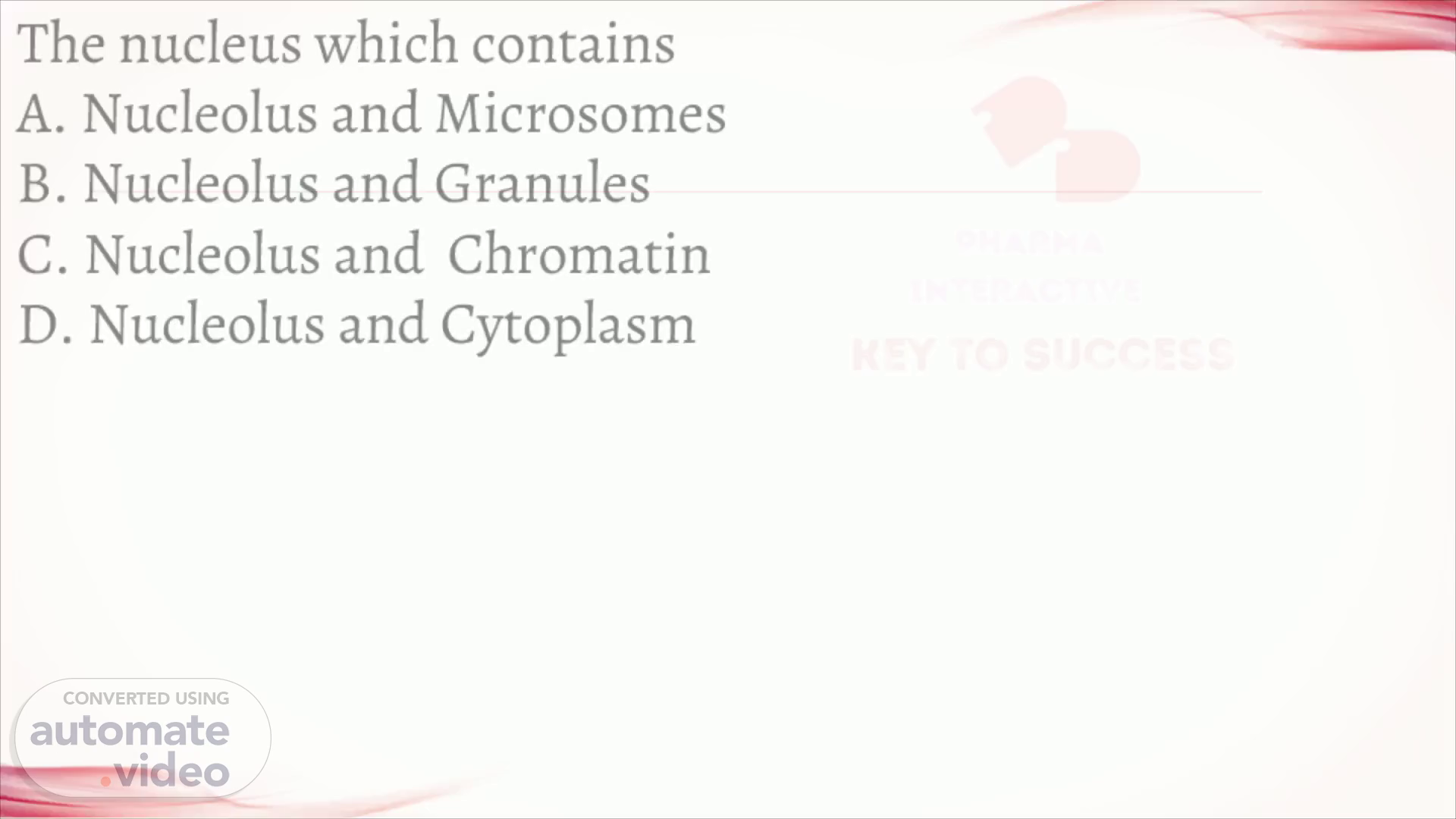Scene 1 (0s)
Ans : Nucleolus and Chromatin.
Scene 2 (13s)
Ans : Ingestion and Metabolism. The cell ingests chemical substances like amino acids from intracellular or interstital fluid is called A. Telophase B. Metabolism C. Irritability D. Ingestion and Meatabolism.
Scene 3 (25s)
Ans : Metabolism. Anabolism and Catabolism are the two process involved in A Excretion B Metabolism C Assimilation D. Secretion.
Scene 4 (35s)
DIFFERENCES BETWEEN CATABOLISM AND ANABOLISM Molecules 00 0 Smaller units ENERGY 00 0 00 0 Smaller units Molea-lles ENERGY CATABOLISM CATABOLISM IS THE SET OF METABOLIC PATHWAYS THAT BREAKS DOWN MOLECULES INTO SMALLER UNITS THAT ARE EITHER OXIDIZED TO RELEASE ENERGY OR USED IN OTHER ANABOLIC REACTIONS. ANABOLISM ANABOLISM IS THE SET OF METABOLIC PATHWAYS THAT CONSTRUCT MOLECULES FROM SMALLER UNITS, THESE REACTIONS REQUIRE ENERGY, KNOWN ALSO AS AN ENDERGONIC PRæESS..
Scene 5 (52s)
Ans : Fats. Bile salts are essential to digest A. Carbohydrates B. Vitamins C. Fats D. Protein.
Scene 6 (1m 2s)
Ans : Liver. Biggest gland in the body A. Thyroid B. Pancreas C. Liver D. Suprarenal glands.
Scene 7 (1m 13s)
Main Functions of the Liver PRODUCES BILE — Elimination of toxins — Fat emulsifier — Helps alkalinize Sl with HC03 — Aids in vit K absorption from gut CLOTTING — Produces clotting factors, prothrombin & fibrinogen (+Vit K above) ENDOCRINE FUNCTIONS — Secretes Insulin like growth factor (IGF-I) aka Somatomedin C - Converts 600/0 of T4 IMMUNE FUNCTIONS — Kupffer Cells ingest old RBCs, WBCs, viruses, and bacteria that enter though the small intestine — Produces Complement NUTRIENT STORAGE & RELEASE — Stores Glycogen, makes glucose — Produces cholesterol — Makes apoproteins for fats to travel around the body — Stores vitamin ADEK Regulates amino acid levels in blood — stores Fe (ferritin), Cu ACTIVATION OF VIT D — Liver adds 1st OH to form hydroxy vitamin D3 Produces blood plasma proteins (albumin) that create the blood colloid osmotic pressure DETOXIFICATION — Makes fat soluble drugs, hormones, waste products water soluble & excretes it through bile — Converts poisonous ammonia from protein metabolism into urea.
Scene 8 (1m 45s)
Liver Gall- bladder Large intestine Anatomy Spleen Stomach Srnall intestine adam.com ten reres • Largest organ in body (N3 lb) • located in the right upper quadrant, behind ribs, between the fifth intercostal space (below nipple) at the midclavicular line and the right costal margin. • It extends across the midline. • The falciform ligament divides the liver into right & left lobes & suspends the liver from the diaphragm.
Scene 10 (2m 7s)
Stomach Small intestine Duodenum Jejunu Ileum Large intestine (Ølon) Anatomy of Small Intestine.
Scene 11 (2m 19s)
Ans : Heart. Sinoatrial node Atrioventricular node Buzzle com Bachmann's bundle Bundle of His Purkinje fibers.
Scene 12 (2m 30s)
Ans : Glucagon. Alpha cells of Pancreas secrete A. Insulin B. Bile salts C. Glucagon D. Gastric Juice.
Scene 13 (2m 41s)
Ans : Chylomicrons. Triglycerides travel through lymphatic vessels in the form of small particles called A. Micelles B. Small globules C. Chylomicrons D. Globules.
Scene 14 (2m 52s)
CHYLOMICRON STRUCTURE Free cholesterol Phospholipid Cholesterol esters Triglyceride Esterified cholesterol Apolipoprotein.
Scene 15 (2m 59s)
Ans : Hcl. Parietal cells secrete A. Pepsin B. Pepsinogen C. Extrinsic Factor D. Hcl.
Scene 16 (3m 9s)
PARIETAL CELL HYDROO& JUNCTIONAL COMPLEX TUBULOVESICLES GOLGI COMPLEX LYSOSOMES MICROVILLI CANALICULI MITOCHONDRION NUCLEUS ENDOPLASMIC RETICULUM.
Scene 17 (3m 15s)
The parietal cells are located in the middle part of the glands of the fundus-body region of the stomach. They secrete gastric acid approximately 0.16 M, pH ≥ 0.8) and secrete the intrinsic factor, which is a vitamin B12-binding protein. Parietal cells otherwise known as Oxyntic cells..
Scene 18 (3m 32s)
Gastric juice has the following enzymes except A. Renin B. Lipase C. Pepsinogen D. Pytalin.
Scene 19 (3m 42s)
Functions of Gastric Juice Functions of Pepsinogen • Pepsinogen, an inactive enzyme produced by chief cells. • It is stored in zymogen granules in the secretary vesicles in the cytoplasm of chief cells. • It is released by exocytosis. • Pepsinogen is converted to active pepsin by HCL. 14.
